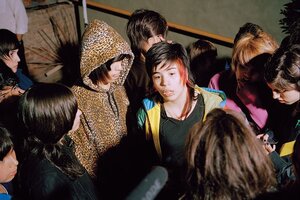Argentina: In a 'me.com' world, 'floggers' flourish

Agustina Vivero, a ‘flogger’ known as ‘Cumbio’ (center), is an Internet sensation.
Emiliano Granado
• A local, slice-of-life story from a Monitor correspondent.
BUENOS AIRES – Every day after school, a crowd of teenagers can be found at the Abasto Shopping Center. They don’t belong to the usual coterie of unkempt, motley mall rats.
For one, their wardrobe is impeccable. They wear skinny jeans with no belt, the waistline sagging down. Most sport fluorescent T-shirts with drooping V-necks. Buckets of hair product complete the look.
Each carries that ubiquitous teen accessory: a mobile phone with built-in camera. When they’re not chatting or checking their hair, they’re snapping photos of themselves. The most proficient combine the two activities.
These are the “floggers,” photo-bloggers, a phenomenon currently taking Argentine teen culture by storm. Unlike youth movements of the past, floggers don’t want to change the world. They don’t even get riled up about it. The initiation rules are simple: Digitize your life on camera, upload the results online, and share with your friends.
Flogging is largely a middle- and upper-class phenomenon. Floggers need access to the Internet, preferably broadband. Argentina has one of the highest Internet access rates in South America, but domestic Web access is dominated by well-off families.
Floggers need time on their hands, too. Being a flogger is a time-intensive job, requiring attention to dress and constant online updates. Most are schoolchildren, from as young as 10 to around 18. (It’s not “cool” for university students to be floggers.)
In the land that gave birth to Che Guevara, teen revolution seems to have become centered on self rather than society. What happened to their parents’ political idealism? Three things, according to Marcelo Urresti, a sociologist at the University of Buenos Aires: the ascendancy of communications technology, the cult of celebrity, and the emergence of a “me.com” mentality.
The result is a capitalist revolution of a peculiarly mainstream variety. “Floggers have no conflict with brands. They are 100 percent consumers, very image conscious. Their thing is to push fashion trends to the absolute extreme,” Mr. Urresti explains.
This generation’s choice of role model proves his point. A middle-class 17-year-old from the suburbs, Agustina Vivero attracts more than 30,000 hits to her blog every day. The queen of floggers is paid handsomely to attend nightclubs and model for Nike. Known by her online moniker “Cumbio,” her autobiography is now on sale.
Cumbio, with her sculpted hair and androgynous appearance, stands in stark contrast to the rail-thin standards typical of Argentina’s models. I ask the floggers in Abasto what special qualities make her stand out. They struggle for an answer. All they know is that she’s popular.
And her photo blog gets more hits than anybody else’s. For Argentina’s floggers, that’s reason enough to adore.
